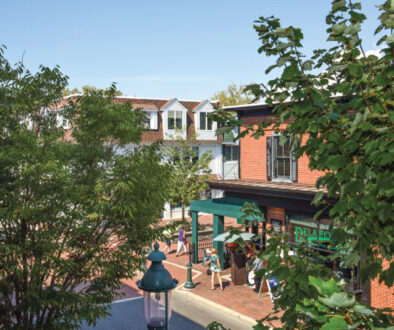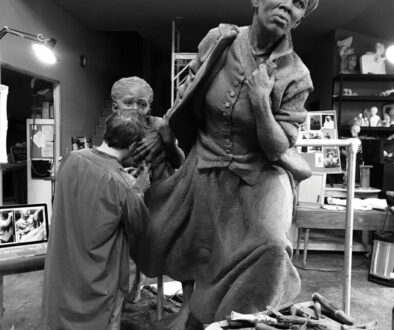Neither Snow Nor Rain… a History of the Cape May Post Office
Even now that our primary communication is by text, email, phone, or social media, the United States Postal Service remains important enough in our lives that we continue to complain about slow service or long lines even while complimenting the many postal carriers who deliver our mail—particularly in the past year.

A formal postal service has been around since Benjamin Franklin—appointed in 1775 as the first Postmaster General—started developing one as the Revolution began. An organized means of communication among the 13 colonies was essential to uniting the new nation of previously separate entities. In that early time, days and weeks transpired before people received letters sent to them, often from what today is a place only a few hours away. Letter delivery was very unpredictable, often taking a long time to get to the recipient, if they were received at all. Letters were frequently lost or damaged, and often stolen for the currency they might contain. One of Franklin’s accomplishments was to designate people to carry the mail, locations to where the mail would be carried, and specific routes along which the mail would travel.
In Cape May County, it took about 25 years before post offices were established, first in Dennisville in 1802 and then at Cape May Court House in 1803. The third post office was established in 1804 on Cape Island. Over the next century, post offices were established in even the smallest communities in the county. At one point there were 45 separate post offices in Cape May County, many of which were discontinued or merged into the 21 that are still in operation today. Even some very small ones, like Cape May Point, are still serving their communities.
In the early 1800s, regularly scheduled stagecoach travel left from Camden, then called Cooper’s Ferry, on Thursday morning and eventually got to Cape Island by late Friday. People who wished to send a letter or package often used the stagecoaches. At that time, some ships stopped at Cape Island on their way between the Atlantic Ocean and Philadelphia, and these ships also were used to transport mail, but their voyages were unpredictable at best.
In the early years, the Postmaster General, a presidential-appointed person in charge of all postal service for the United States, appointed a postmaster in various designated communities. Both the size of a community as well as political connections had something to do with when a postmaster was appointed.The local postmaster was responsible for and in charge of mail service within that designated community. Many of them operated the postal service out of their homes or businesses. Separate post office buildings were not common until the 1890s and into the 20th century.

Ellis Hughes was the first appointed postmaster for Cape Island and operated the post office from his Atlantic House, where he took in boarders during the summer season. Anyone who wanted to send a letter would leave it with the postmaster who would make sure it was in the packet to be carried by the stagecoach driver. In the early 1800s, only about 3,000 people resided in all of Cape May County, with about 500 living all year on Cape Island. Many of the letters were between people living within the county where even then it could take several days for letters to go from say, Dennisville to Cape Island.
Alexander Mackenzie purchased the Atlantic House after Ellis Hughes’ death and was appointed the postmaster in 1820. He continued the post office from the Atlantic House until 1833, when it was relocated by newly appointed postmaster Joseph B. Hughes to Congress Hall, where he was the proprietor, and then stayed at Congress Hall when Jonas Miller purchased the hotel in 1835 and was appointed postmaster. Postmasters changed about every three or four years throughout the 19th century. Most of the appointees were prominent Cape May citizens who were active in the town business and government. By this time, postal routes were defined by the national postal service.
In 1835, and for many years after until mail transportation was fully transferred to the railroad, the route between Bridgeton and Cape May was advertised in the Trenton Emporium and True American and bid upon for generally two-to-four-year contract periods. This route went “from Bridgeton by Millville, Port Elizabeth, Dennis Creek, Goshen, Cape May (Court House), Fishing Creek, Cold Spring, to Cape Island, 50 miles and back twice a week in stages. Leave Bridgeton every Tuesday and Saturday at 4am, arrive at Cape Island same days at 3pm. Leave Cape Island every Monday and Friday at 4am, arrive at Bridgeton same day by 3pm” via stagecoach. Anyone taking Route 47 into Cape May today will recognize this mail route, a drive today of a little more than an hour (of course, dependent on traffic).
By 1844, additional routes were established between Philadelphia and Cape Island, especially during the summer months, but went from Camden and Tuckahoe and then to Goshen and through each of the inland bayside towns into Cape Island. Additionally, “Proposals to carry in steamboats to Cape Island and back…three times a week or more” during the visiting season were also to be considered. Even with established routes and predictable service, patrons frequently complained about efficiency. The correspondent for the Public Ledger in 1850 noted that “Complaints, loud and oft repeated, are uttered at the management of the post office at Cape May, the delivery of letters being delayed upon every arrival of the mail until patience ceases to be an accomplishment.” The correspondent continued by suggesting that additional help should be hired for the postmaster at least “during the bathing season when there are more than 5000 visitors on the Island.”
Joseph Leach, owner and editor of the Cape May Ocean Wave, used his position to advocate strongly for a railroad line to Cape May. A railroad was not universally supported by the townspeople. Many years, a great deal of debate, and several unsuccessful attempts to establish a railroad took place. The train finally arrived in 1863 and soon replaced both stagecoaches and steamboats as the primary mail transporter. When Leach became postmaster in 1866, the newspaper’s office became the place where citizens received and sent mail. Mail now came daily on the train, and Leach followed the custom used in many different cities across the country where names of people with letters being held for pick-up were published in the newspaper. Other than people checking in at the post office regularly, these published lists were a primary way of letting them know to retrieve a letter. In smaller communities, the train did not even stop. The train conductor would reach the mail bag out the window and hang it on a pole for the postmaster to retrieve and take it back to the post office for distribution.
Post offices were grouped into five classes by their gross receipts, with first class assigned to those with the highest receipts. Class assignment also determined the salary of the postmaster and by whom the postmaster was appointed—the President or the Postmaster General. Cape May County post offices were small and had low receipts (and low-class assignments), but the job of postmaster seems to have been both political and desired.
A story is recounted about Cape May County Common Pleas Judge Joseph E. Hughes who desired to be appointed as postmaster for Cape May City. After traveling to and staying for several days in Washington, D.C., through an acquaintance, the Judge was able to make contact with the New Jersey Congressman and former Navy Secretary George Robeson. After spending the day with the Secretary at his home, he left with the papers for his appointment, which he held in Cape May from 1882 to 1886.

Atlantic House (far right) in proximity to Congress Hall (center) depicted as it appeared before the 1878 fire. Postcard from our archives. 
The Atlantic House, Cape May’s first hotel owned by Ellis Hughes, and the seat of the first post office. Postcard from our archives. 
A postcard showing the post office’s former location on Washington Street. Courtesy of Richard Gibbs.
By the early 1900s, mail was used as a primary means of communication. In some communities, mail was delivered twice a day. A note could be sent in the morning, delivered to the recipient, and a response delivered back to the sender by the afternoon. Postcards gained in popularity, even though they had been around for several decades. With the advent and widespread adoption of picture postcards, these souvenir cards became a primary way of letting people know where you were and what you were doing—a lot slower than today’s texting and Instagram, but maybe the same idea of sharing pictures and memories with others.
In April 1903, a few days after the death of Postmaster Walter S. Leaming, Cape May was classified as a 2nd class post office and William Williams was appointed as the postmaster. For the first time, free mail delivery was established. The first mailmen were Richard Stansbury, Henry Walker Hand, and Charles Briant who were backed up by three substitutes: Henry Daugherty, Harry Bellangy, and Walter Coverdale.
The post office was no longer housed in Congress Hall or the Ocean Wave offices but was in its own building on Washington Street. It was not uncommon for post offices to be robbed, and many newspaper stories described robberies in post offices all across the country. Cape May was not exempt. The 1901 Reading Times described a robbery in the Cape May post office where the safe was blown open with a torch, $200 was stolen, and every letter was slit open, possibly yielding additional money. The robbers were described as professionals who entered through a back window and “rifled every part and parcel of it where there was likely to be any money or stamps.” Perhaps this was an impetus for the post office to move into its new brick building at 210 Ocean Street, where it shared space with the newly developing telephone company. Twenty years later, in 1923, the post office had outgrown its space on Ocean Street and moved into the newly built Focer-McCray Building on Washington Street, on the block where Victorian Towers is today.
The present post office building on Washington and Franklin Streets has served Cape May since 1938, when it was built with Treasury Department funds during the depression as part of Roosevelt’s New Deal. The Treasury Department funded a number of post office projects across the country. The Cape May Post Office is one of three constructed by Sofarelli Bros. Inc. Built on land where the National Hotel had been located before being demolished, this 80-year-old post office is an architecturally handsome building that resembles other Treasury Department-funded post office buildings of that time. Even in our modern times, the Cape May post office continues its 220-year-old mission by serving as a hub for mail distribution to communities and smaller post offices throughout the southern Cape, and as a social place where many people meet each other as they drop off and pick up mail and post packages.






